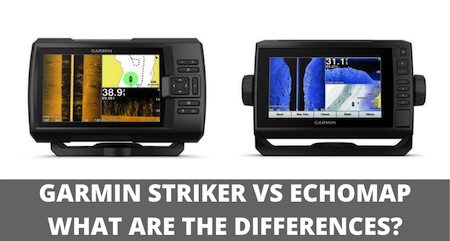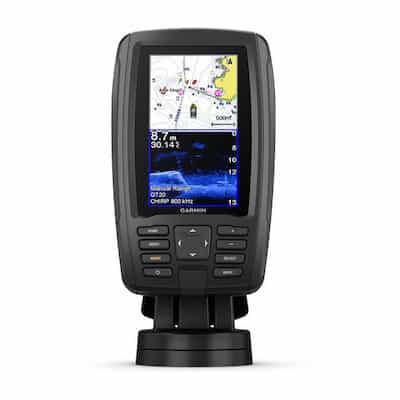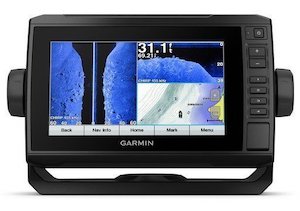What Is The Difference Between Garmin Striker And Echomap?
UPDATED 15 SEPTEMBER 2023
by Robert Ceran
This article may contain affiliate links. If you make a purchase after clicking on a link we may earn a small commission at no extra cost to you.
Garmin produces some of the finest fish finder electronics on the market, and two or their most popular lineups are the Striker and Echomap series.
However, the problem with these fish finder series is that they come in a bewildering array of models, variations, and sizes.
For this article we tested the Striker Plus series (which has replaced the Striker series) as well as the Echomap series, and compared them side by side, to help decide which model is best for your purpose.

Garmin Striker vs Echomap series compared side by side
The table above compares the most important specifications of Striker Plus models with Echomap models of comparable size and sonar capability that we tested.
As you can see, you really have to look at the details in order to understand the differences between the two lineups, and also between specific models.
Now let’s dive into the details and take a closer look at the main differences between the Striker Plus and Echomap UHD lineups.
The most important differences between the Striker Plus and Echomap series discussed
Preloaded maps: This is the first area where our testing revealed very big differences between the two series.
None of the models in the Striker Plus series comes with preloaded maps. Since none of them have a microSD card slot either, this means you can’t load any maps on to them.
In contrast to this, the Echomap UHD 73CV and 73SV models come with LakeVu HD maps preloaded.
The Echomap Plus 45CV, however, does not come with preloaded maps. But since all Echomap units have a microSD card slot, you can load maps onto to them that way.
Bottom line: None of the Striker Plus models have preloaded maps, nor a microSD slot to add them, which means you can only use them as pure fish finders, without any real mapping functionality.
In contrast, Echomap models come with preloaded maps (except for the smallest models), and all of them have a microSD card slot to load additional maps, and when we tested them we found you can use them both as fish finders and for mapping.
MicroSD card slot: As already mentioned above, during our tested we found that this is another area with major differences between the two series.
None of the Striker Plus models have a microSD card slot, while all Echomap models do.
This underscores the intention of the manufacturers for the Striker Plus series to be used as pure fish finders, while the Echomap series combines fish finder functionality with state of the art mapping capability.
Wi-Fi: The larger models of both series have wi-fi functionality, while the smaller models don’t.
CHIRP sonar: There is no real difference between the two series in this regard, as almost all models have CHIRP sonar (except for the Striker Plus 4).
CHIRP has become a basic feature of most Garmin fish finders nowadays, which is great, since our test results show that it translates into higher quality sonar imaging.
ClearVu: This is Garmin’s version of down imaging, and is a basic feature included in all models of both series.
SideVu: This is Garmin’s version of side imaging, and is only included on the high end models in both series (the Striker Plus 7SV and the Echomap UHD 73SV).
The differences here are not between the two lineups, but rather between the high end and low end models in each lineup.
GPS: This is included as a basic feature in all models of both series.
It should be noted that although the Striker Plus series doesn’t include any real mapping capabilities, you can place GPS waypoints, and use your sonar data to create your own maps with Quickdraw.
Display size: There is no difference between the two series in this regard.
Screen resolution: There is no difference between the two lineups in this category.
Now let’s look at each of the models in more detail.
Garmin Striker Plus 4


This is the smallest Striker Plus model, and during our testing we found that it is a great size for kayak fishing, or for use as a portable fish finder.
This is also the cheapest model, and provides very solid sonar functionality at an affordable price.
However, you should note that it doesn’t have CHIRP (only traditional 2D sonar).
Features:
- Display size: 4.3” diagonal
- Screen resolution: 480 x 270
- Transducer: dual beam
- Frequencies: 77/220 kHz
Garmin Echomap Plus 44CV


This is the smallest Echomap model, and is similar in size to the Striker Plus 4.
But it also includes CHIRP and ClearVu down imaging, which translates into a huge improvement in terms of sonar capabilities. It also comes with a microSD slot.
However, due to its relatively small size, our testing revealed that it’s not really useful for complex mapping, which is probably why Garmin doesn’t include preloaded maps.
So if you’re really keen on the mapping functionality, it’s better to get one of the larger Echomap models.
Features:
- Display size: 4.3” diagonal
- Screen resolution: 480 x 270
- Transducer: dual beam
- Frequencies: 50/77/83/220 kHz
Garmin Striker Plus 7CV


This model has a generous screen size of 7 inches, and comes at an excellent price point compared to the value it packs.
It comes with CHIRP and 2D sonar, but doesn’t include SideVu side scanning functionality. If you want this feature, you need to get the 7SV model instead.
Features:
- Display size: 7” diagonal
- Screen resolution: 800 x 480
- Sonar technologies: ClearVu, CHIRP
- Wi-Fi connectivity: yes
Garmin Echomap UHD 73CV


The UHD 73CV comes preloaded with LakeVu HD G3 maps, and combined with its large 7 inch screen size, this means you can use the split screen functionality to combine sonar read outs with mapping navigation.
Many anglers want to use preloaded maps in addition to fish finder functionality, and this model provides these functions at a great price.
Features:
- Display size: 7” diagonal
- Screen resolution: 800 x 480
- Preloaded charts: LakeVu G3
- Sonar technologies: ClearVu, CHIRP
Garmin Striker Plus 7SV


This is the flagship model in the Striker Plus series, and comes with some of the most cutting edge sonar technologies produced by Garmin, including SideVu side scan functionality.
During our testing we found that side scan imaging can be extremely useful to cover large areas to find promising spots to zoom in on, which helps to catch a lot more fish.
While the Striker Plus 7SV can’t be used for mapping, it does provide some of the finest fish finder sonar technology currently on the market at less than $500.
Features:
- Display size: 7” diagonal
- Screen resolution: 800 x 480
- Transducer: CV52HW-TM
- Wi-Fi connectivity: yes
Garmin Echomap UHD 73SV


Just like the Striker Plus 7SV, this model also includes SideVu side scan sonar, and thus it combines the cutting edge sonar capabilities of the 7SV with high end mapping functionality.
That means you can use preloaded maps to navigate to the most promising spots right away, and then scan those spots with the full array of SideVu, ClearVu, and CHIRP.
When we put it to the test we found that this gives you the edge when it comes to finding fish, especially on large bodies of water that you aren’t familiar with.
Also, you can get this unit without transducer to set up the best LiveScope for the money.
Features:
- Display size: 7” diagonal
- Screen resolution: 800 x 480
- Preloaded charts: LakeVu G3
- Sonar technologies: SideVu, ClearVu, CHIRP
Conclusion
To summarize: the Striker Plus series provides state of the art Garmin sonar functionalities, but without the ability to use preloaded maps.
In contrast to this, the Echomap series includes all the sonar functionalities of the Striker Plus series, but in addition it also provides the ability to use preloaded maps for navigation.
This is especially useful on the larger models with split screen functionality.
The Echomap series is compatible with Lakemaster maps, which means you can load their highly detailed lake maps on to your fish finder (for more details on this, check out our article Navionics vs Lakemaster – what are the pros and cons).
Gear and methods used for testing
For consistent testing results to compare Garmin Echomap vs Striker units, we tested all fish finder units reviewed in this article with either a Garmin GT56UHD-TM transducer (for Echomap models) or a Garmin GT23M-TM transducer (for Striker Plus models) transom mounted on a Ranger Z520R bass boat. We tested both series on the same day on Lake Tarpon, to make sure we could compare their performance side by side under similar conditions. Testing was performed by imaging schools of fish relating to structure in 6 to 21 feet of water.




